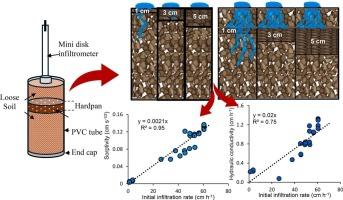浅层硬土层属性影响土壤表面和地下水力特性
IF 5.7
1区 农林科学
Q1 GEOSCIENCES, MULTIDISCIPLINARY
引用次数: 0
摘要
硬层发育程度是决定土壤水力特性的关键因素。缺乏关于几厘米的浅深薄硬土层如何影响土壤表面和地下水力特性的信息。本研究旨在评估硬土厚度(THP1)、(1.7 g cm−3体积密度)和硬土深度(DHP2)对初始入渗速率(Ii)、不饱和水导率(K)、吸附率(SW)和稳态入渗速率(ISS)的影响。在制备的土柱中进行了3个THP水平(1 cm: THP1, 3 cm: THP3, 5 cm: THP5)和4个DHP水平(0 cm: DHP0, 1 cm: DHP1, 3 cm: DHP3, 5 cm: DHP5)的试验。采用迷你盘式渗透仪测量土壤水力特性。与对照相比,所有硬盘土壤柱的Ii、K、SW和ISS均显著降低(p < 0.05)。表面硬度(DHP0)显示,与对照相比,Ii、K和SW下降了90%。与对照相比,DHP1、Ii、K、SW和ISS在三个厚度水平上分别减少了19 - 44%、71 - 95%、43 - 57%和50 - 70%。随着DHP的升高(DHP3、DHP5),这些参数的下降百分比逐渐减小,在DHP5时更接近控制值。厚度为1 cm的硬土层在停滞期约60 s后,累积入渗量增加,表明水流有可能通过硬土层。Ii与SW和K呈显著的线性正相关,表明地表水进入受阻不仅影响地表水的吸收,而且影响土壤内的水分运动。目前的研究进一步证实,由于浅层硬化层导致孔隙几何形状减小,地表和地下水力特性都会受到不利影响。在不同土壤类型下,浅埋硬垫层对土壤水力特性的影响有待进一步的试验研究。本文章由计算机程序翻译,如有差异,请以英文原文为准。

Shallow-depth hardpan attributes influence soil surface and subsurface hydraulic properties
Hardpan development is a crucial factor in determining soil hydraulic properties. Information lacks on how shallow-depth thin hardpans of a few centimeters influence soil surface and subsurface hydraulic properties. The present study aimed to assess effects of thickness of hardpan (THP1), (1.7 g cm−3 bulk density) and depth to the hardpan (DHP2) on initial infiltration rate (Ii), unsaturated hydraulic conductivity (K), sorptivity (SW), and steady-state infiltration rate (ISS). Three THP levels (1 cm: THP1, 3 cm: THP3, 5 cm: THP5) and four DHP levels (0 cm: DHP0, 1 cm: DHP1, 3 cm: DHP3, 5 cm: DHP5) were tested in the experiment with a control (no hardpan) in prepared soil columns. Soil hydraulic properties were measured using a Mini disk infiltrometer. All soil columns with hardpans showed significantly lower Ii, K, SW, and ISS compared with the control (p < 0.05). Surface hardpan (DHP0) revealed >90 % decline in Ii, K, and SW compared with the control. At DHP1, Ii, K, SW, and ISS showed 19–44 %, 71–95 %, 43–57 %, and 50–70 % reductions, respectively, at the three thickness levels compared with the control. As DHP increased (DHP3, DHP5), the percentage declines of these parameters gradually decreased, showing their values closer to control at DHP5. Hardpans with 1 cm thickness showed an increase in cumulative infiltration after ∼60 s stagnant period, suggesting a potential for water flow to pass through the hardpan. The Ii showed strong positive linear correlations with SW and K confirming that impeded surface water-entry not only influences surface water absorption, but also influences water movements within the soil. Present study further confirms that both surface and subsurface hydraulic properties can be detrimentally affected as a result of diminished pore geometry due to shallow-depth hardpans. Further experiments are required to explore the effects of shallow-depth hardpans on soil hydraulic properties with different soil types.
求助全文
通过发布文献求助,成功后即可免费获取论文全文。
去求助
来源期刊

Catena
环境科学-地球科学综合
CiteScore
10.50
自引率
9.70%
发文量
816
审稿时长
54 days
期刊介绍:
Catena publishes papers describing original field and laboratory investigations and reviews on geoecology and landscape evolution with emphasis on interdisciplinary aspects of soil science, hydrology and geomorphology. It aims to disseminate new knowledge and foster better understanding of the physical environment, of evolutionary sequences that have resulted in past and current landscapes, and of the natural processes that are likely to determine the fate of our terrestrial environment.
Papers within any one of the above topics are welcome provided they are of sufficiently wide interest and relevance.
 求助内容:
求助内容: 应助结果提醒方式:
应助结果提醒方式:


